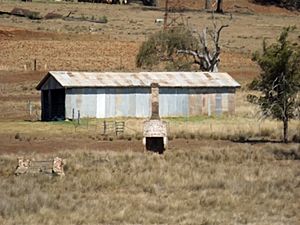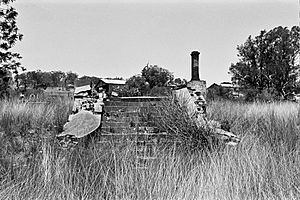Eton Vale Homestead Ruins facts for kids
Quick facts for kids Eton Vale Homestead Ruins |
|
|---|---|

Chimney remains, 1992
|
|
| Location | New England Highway, Cambooya, Toowoomba Region, Queensland, Australia |
| Design period | 1840s–1860s (mid-19th century) |
| Built | c. 1840–1880 |
| Official name: Eton Vale Homestead Ruins | |
| Type | state heritage (archaeological) |
| Designated | 21 October 1992 |
| Reference no. | 600391 |
| Significant period | 1840s (historical) 1840s–1880s (fabric) |
| Significant components | steps/stairway, well, wall/s, views from, chimney/chimney stack, views to, ruin/s |
| Lua error in Module:Location_map at line 420: attempt to index field 'wikibase' (a nil value). | |
The Eton Vale Homestead Ruins are the remains of an old house in Cambooya, Queensland, Australia. This historic site is found along the New England Highway.
The original house was started around 1840 by Arthur Hodgson. Sadly, a fire destroyed it in 1912. Today, the ruins are protected as a heritage-listed site. They were added to the Queensland Heritage Register on October 21, 1992.
Contents
A Glimpse into the Past
How Eton Vale Began
Eton Vale Station was a large property started in 1840. Brothers Arthur Hodgson and Christopher Pemberton Hodgson founded it. They were among the first settlers to claim land on the Darling Downs. It was the second property ever claimed in Queensland.
At first, Eton Vale was a huge area, about 268 square kilometers. It was mainly used for grazing animals. Later, in 1846, they started growing wheat. By 1850, it became a special sheep farm.
Building the Homestead
The first house built around 1840 was a simple slab hut. Over time, this hut became the center of a much larger brick home. People kept adding to the house until about 1880.
In the late 1840s, settlers on the Darling Downs could buy their land. The Darling Downs became known as a very rich area. Many important families lived there in fancy homes.
A Village on the Station
At its busiest, Eton Vale Station was like a small village. It had homes for workers and even a school. There were also many other buildings for farm work. Arthur Hodgson wanted Eton Vale to look like an English village. He cared a lot about his workers and their families.
John Watts was Hodgson's manager. He later became a partner in the station. Watts took over running the station from the 1850s. Later, Robert Ramsay bought Watts' share.
All three men – Hodgson, Watts, and Ramsay – were important. They were leaders in the local area. They also served as members of parliament and government ministers. Eventually, they all moved back to England. Watts left in 1867, Hodgson in 1870, and Ramsay in 1883.
Changes Over Time
New land laws from 1863 slowly made the property smaller. In 1877, about 6,500 acres of Eton Vale land were taken. This land was then divided into smaller farms. It was offered to new settlers on April 17, 1877.
Even with these changes, Hodgson still owned a large area. In 1897, he had about 130 square kilometers. That same year, Eton Vale was split between Ramsay and Hodgson. Ramsay's part was renamed Harrow.
After Arthur Hodgson died in 1902, the rest of the property was sold off. In 1906, Christian Barth bought the homestead and the land around it. He was a German saddler. Sadly, the homestead burned down in 1912.
In 1932, Frederick Robotham bought Eton Vale. His family still owns the property today. Robotham built a new farmhouse nearby. The old homestead ruins have slowly worn away over the years.
What the Ruins Look Like
The Eton Vale homestead ruins are on a gentle slope. This slope goes down towards Hodgson Creek. From the west, the house would have looked grand, overlooking the fields.
Today, a single brick chimney stands out among the ruins. You can also see two sets of stairs. These stairs were made of brick covered in cement. They sit on stone and mortar foundations. There are also some old hearths, which are like old fireplaces. You might find pieces of old timber stumps and other building materials scattered around.
A well is located to the north-west of where the house once stood. The way the ruins are placed tells us about the house's layout. The main entrance stairs were on the west side. There were also stairs on the north. A large chimney, probably for the kitchen, was at the back on the east side. Five old timber stumps show where the northern edge of the house was. The hearths are found between the stairs, stumps, and chimney.
The ground is covered with bricks, some stamped "Toowoomba". You can also find old steel parts, glass, and terracotta pieces. Two bunya pine trees stand near the house site. They might have been part of the homestead's garden. The well still has parts of a steel pulley on a timber frame.
Why Eton Vale is Important
Eton Vale Homestead Ruins was added to the Queensland Heritage Register on October 21, 1992. It meets several important standards.
- Showing Queensland's History: The ruins help us understand how Queensland's history unfolded. They are the remains of buildings from the second oldest and a very important property in the Darling Downs area.
- Learning from the Past: The site can teach us a lot about Queensland's history. The ruins clearly show where the house was built. They also reveal where important parts of the house were located.
- Beautiful Scenery: The landscape and what's left of the garden are considered beautiful. People in the community value their look and feel.
- Connected to Important People: The ruins have a special link to Arthur Hodgson. He was an important early settler and a well-known politician in Queensland.



